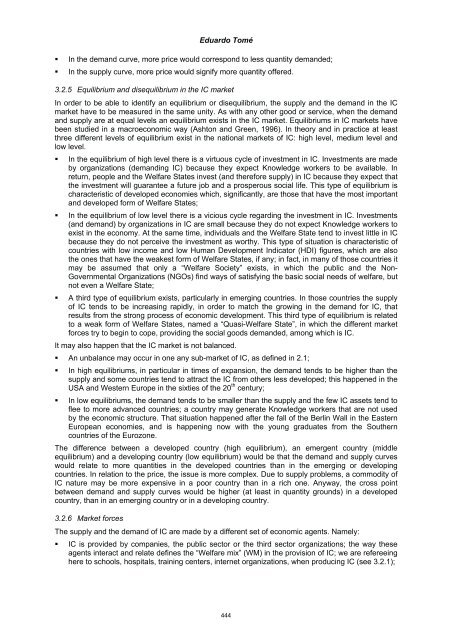Proceedings of the 3rd European Conference on Intellectual Capital
Proceedings of the 3rd European Conference on Intellectual Capital
Proceedings of the 3rd European Conference on Intellectual Capital
Create successful ePaper yourself
Turn your PDF publications into a flip-book with our unique Google optimized e-Paper software.
Eduardo Tomé<br />
In <str<strong>on</strong>g>the</str<strong>on</strong>g> demand curve, more price would corresp<strong>on</strong>d to less quantity demanded;<br />
In <str<strong>on</strong>g>the</str<strong>on</strong>g> supply curve, more price would signify more quantity <str<strong>on</strong>g>of</str<strong>on</strong>g>fered.<br />
3.2.5 Equilibrium and disequilibrium in <str<strong>on</strong>g>the</str<strong>on</strong>g> IC market<br />
In order to be able to identify an equilibrium or disequilibrium, <str<strong>on</strong>g>the</str<strong>on</strong>g> supply and <str<strong>on</strong>g>the</str<strong>on</strong>g> demand in <str<strong>on</strong>g>the</str<strong>on</strong>g> IC<br />
market have to be measured in <str<strong>on</strong>g>the</str<strong>on</strong>g> same unity. As with any o<str<strong>on</strong>g>the</str<strong>on</strong>g>r good or service, when <str<strong>on</strong>g>the</str<strong>on</strong>g> demand<br />
and supply are at equal levels an equilibrium exists in <str<strong>on</strong>g>the</str<strong>on</strong>g> IC market. Equilibriums in IC markets have<br />
been studied in a macroec<strong>on</strong>omic way (Asht<strong>on</strong> and Green, 1996). In <str<strong>on</strong>g>the</str<strong>on</strong>g>ory and in practice at least<br />
three different levels <str<strong>on</strong>g>of</str<strong>on</strong>g> equilibrium exist in <str<strong>on</strong>g>the</str<strong>on</strong>g> nati<strong>on</strong>al markets <str<strong>on</strong>g>of</str<strong>on</strong>g> IC: high level, medium level and<br />
low level.<br />
In <str<strong>on</strong>g>the</str<strong>on</strong>g> equilibrium <str<strong>on</strong>g>of</str<strong>on</strong>g> high level <str<strong>on</strong>g>the</str<strong>on</strong>g>re is a virtuous cycle <str<strong>on</strong>g>of</str<strong>on</strong>g> investment in IC. Investments are made<br />
by organizati<strong>on</strong>s (demanding IC) because <str<strong>on</strong>g>the</str<strong>on</strong>g>y expect Knowledge workers to be available. In<br />
return, people and <str<strong>on</strong>g>the</str<strong>on</strong>g> Welfare States invest (and <str<strong>on</strong>g>the</str<strong>on</strong>g>refore supply) in IC because <str<strong>on</strong>g>the</str<strong>on</strong>g>y expect that<br />
<str<strong>on</strong>g>the</str<strong>on</strong>g> investment will guarantee a future job and a prosperous social life. This type <str<strong>on</strong>g>of</str<strong>on</strong>g> equilibrium is<br />
characteristic <str<strong>on</strong>g>of</str<strong>on</strong>g> developed ec<strong>on</strong>omies which, significantly, are those that have <str<strong>on</strong>g>the</str<strong>on</strong>g> most important<br />
and developed form <str<strong>on</strong>g>of</str<strong>on</strong>g> Welfare States;<br />
In <str<strong>on</strong>g>the</str<strong>on</strong>g> equilibrium <str<strong>on</strong>g>of</str<strong>on</strong>g> low level <str<strong>on</strong>g>the</str<strong>on</strong>g>re is a vicious cycle regarding <str<strong>on</strong>g>the</str<strong>on</strong>g> investment in IC. Investments<br />
(and demand) by organizati<strong>on</strong>s in IC are small because <str<strong>on</strong>g>the</str<strong>on</strong>g>y do not expect Knowledge workers to<br />
exist in <str<strong>on</strong>g>the</str<strong>on</strong>g> ec<strong>on</strong>omy. At <str<strong>on</strong>g>the</str<strong>on</strong>g> same time, individuals and <str<strong>on</strong>g>the</str<strong>on</strong>g> Welfare State tend to invest little in IC<br />
because <str<strong>on</strong>g>the</str<strong>on</strong>g>y do not perceive <str<strong>on</strong>g>the</str<strong>on</strong>g> investment as worthy. This type <str<strong>on</strong>g>of</str<strong>on</strong>g> situati<strong>on</strong> is characteristic <str<strong>on</strong>g>of</str<strong>on</strong>g><br />
countries with low income and low Human Development Indicator (HDI) figures, which are also<br />
<str<strong>on</strong>g>the</str<strong>on</strong>g> <strong>on</strong>es that have <str<strong>on</strong>g>the</str<strong>on</strong>g> weakest form <str<strong>on</strong>g>of</str<strong>on</strong>g> Welfare States, if any; in fact, in many <str<strong>on</strong>g>of</str<strong>on</strong>g> those countries it<br />
may be assumed that <strong>on</strong>ly a “Welfare Society” exists, in which <str<strong>on</strong>g>the</str<strong>on</strong>g> public and <str<strong>on</strong>g>the</str<strong>on</strong>g> N<strong>on</strong>-<br />
Governmental Organizati<strong>on</strong>s (NGOs) find ways <str<strong>on</strong>g>of</str<strong>on</strong>g> satisfying <str<strong>on</strong>g>the</str<strong>on</strong>g> basic social needs <str<strong>on</strong>g>of</str<strong>on</strong>g> welfare, but<br />
not even a Welfare State;<br />
A third type <str<strong>on</strong>g>of</str<strong>on</strong>g> equilibrium exists, particularly in emerging countries. In those countries <str<strong>on</strong>g>the</str<strong>on</strong>g> supply<br />
<str<strong>on</strong>g>of</str<strong>on</strong>g> IC tends to be increasing rapidly, in order to match <str<strong>on</strong>g>the</str<strong>on</strong>g> growing in <str<strong>on</strong>g>the</str<strong>on</strong>g> demand for IC, that<br />
results from <str<strong>on</strong>g>the</str<strong>on</strong>g> str<strong>on</strong>g process <str<strong>on</strong>g>of</str<strong>on</strong>g> ec<strong>on</strong>omic development. This third type <str<strong>on</strong>g>of</str<strong>on</strong>g> equilibrium is related<br />
to a weak form <str<strong>on</strong>g>of</str<strong>on</strong>g> Welfare States, named a “Quasi-Welfare State”, in which <str<strong>on</strong>g>the</str<strong>on</strong>g> different market<br />
forces try to begin to cope, providing <str<strong>on</strong>g>the</str<strong>on</strong>g> social goods demanded, am<strong>on</strong>g which is IC.<br />
It may also happen that <str<strong>on</strong>g>the</str<strong>on</strong>g> IC market is not balanced.<br />
An unbalance may occur in <strong>on</strong>e any sub-market <str<strong>on</strong>g>of</str<strong>on</strong>g> IC, as defined in 2.1;<br />
In high equilibriums, in particular in times <str<strong>on</strong>g>of</str<strong>on</strong>g> expansi<strong>on</strong>, <str<strong>on</strong>g>the</str<strong>on</strong>g> demand tends to be higher than <str<strong>on</strong>g>the</str<strong>on</strong>g><br />
supply and some countries tend to attract <str<strong>on</strong>g>the</str<strong>on</strong>g> IC from o<str<strong>on</strong>g>the</str<strong>on</strong>g>rs less developed; this happened in <str<strong>on</strong>g>the</str<strong>on</strong>g><br />
USA and Western Europe in <str<strong>on</strong>g>the</str<strong>on</strong>g> sixties <str<strong>on</strong>g>of</str<strong>on</strong>g> <str<strong>on</strong>g>the</str<strong>on</strong>g> 20 th century;<br />
In low equilibriums, <str<strong>on</strong>g>the</str<strong>on</strong>g> demand tends to be smaller than <str<strong>on</strong>g>the</str<strong>on</strong>g> supply and <str<strong>on</strong>g>the</str<strong>on</strong>g> few IC assets tend to<br />
flee to more advanced countries; a country may generate Knowledge workers that are not used<br />
by <str<strong>on</strong>g>the</str<strong>on</strong>g> ec<strong>on</strong>omic structure. That situati<strong>on</strong> happened after <str<strong>on</strong>g>the</str<strong>on</strong>g> fall <str<strong>on</strong>g>of</str<strong>on</strong>g> <str<strong>on</strong>g>the</str<strong>on</strong>g> Berlin Wall in <str<strong>on</strong>g>the</str<strong>on</strong>g> Eastern<br />
<str<strong>on</strong>g>European</str<strong>on</strong>g> ec<strong>on</strong>omies, and is happening now with <str<strong>on</strong>g>the</str<strong>on</strong>g> young graduates from <str<strong>on</strong>g>the</str<strong>on</strong>g> Sou<str<strong>on</strong>g>the</str<strong>on</strong>g>rn<br />
countries <str<strong>on</strong>g>of</str<strong>on</strong>g> <str<strong>on</strong>g>the</str<strong>on</strong>g> Euroz<strong>on</strong>e.<br />
The difference between a developed country (high equilibrium), an emergent country (middle<br />
equilibrium) and a developing country (low equilibrium) would be that <str<strong>on</strong>g>the</str<strong>on</strong>g> demand and supply curves<br />
would relate to more quantities in <str<strong>on</strong>g>the</str<strong>on</strong>g> developed countries than in <str<strong>on</strong>g>the</str<strong>on</strong>g> emerging or developing<br />
countries. In relati<strong>on</strong> to <str<strong>on</strong>g>the</str<strong>on</strong>g> price, <str<strong>on</strong>g>the</str<strong>on</strong>g> issue is more complex. Due to supply problems, a commodity <str<strong>on</strong>g>of</str<strong>on</strong>g><br />
IC nature may be more expensive in a poor country than in a rich <strong>on</strong>e. Anyway, <str<strong>on</strong>g>the</str<strong>on</strong>g> cross point<br />
between demand and supply curves would be higher (at least in quantity grounds) in a developed<br />
country, than in an emerging country or in a developing country.<br />
3.2.6 Market forces<br />
The supply and <str<strong>on</strong>g>the</str<strong>on</strong>g> demand <str<strong>on</strong>g>of</str<strong>on</strong>g> IC are made by a different set <str<strong>on</strong>g>of</str<strong>on</strong>g> ec<strong>on</strong>omic agents. Namely:<br />
IC is provided by companies, <str<strong>on</strong>g>the</str<strong>on</strong>g> public sector or <str<strong>on</strong>g>the</str<strong>on</strong>g> third sector organizati<strong>on</strong>s; <str<strong>on</strong>g>the</str<strong>on</strong>g> way <str<strong>on</strong>g>the</str<strong>on</strong>g>se<br />
agents interact and relate defines <str<strong>on</strong>g>the</str<strong>on</strong>g> “Welfare mix” (WM) in <str<strong>on</strong>g>the</str<strong>on</strong>g> provisi<strong>on</strong> <str<strong>on</strong>g>of</str<strong>on</strong>g> IC; we are refereeing<br />
here to schools, hospitals, training centers, internet organizati<strong>on</strong>s, when producing IC (see 3.2.1);<br />
444
















